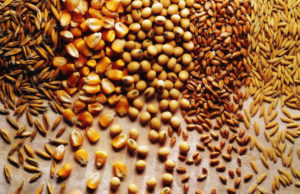 Grain futures were mixed on Tuesday with soybeans marking a minor daily advance, while wheat and corn plunged.
Grain futures were mixed on Tuesday with soybeans marking a minor daily advance, while wheat and corn plunged.
On the Chicago Board of Trade, corn futures for September delivery traded at $5.3438 at 9:45 GMT, down 1.04% on the day. Prices held in range between days high and low of $5.3925 and $5.3413 per bushel respectively. The grain plunged on Monday, extending this weeks decline to over 1.5% after falling 0.18% the preceding one.
Corn was supported recently as favorable weather conditions boosted corn crop prospects. DTN said in a report yesterday that no significant hot weather is expected for the Midwest in the next 10 days, which will favor corn and soybeans developing. Crops in the Delta will benefit from seasonal temperatures and more rains early this week.
Luke Mathews, a commodity strategist at Commonwealth Bank of Australia (CBA), wrote in a report: “Grain traders are currently more focused on corn crops. The absence of extreme heat for the U.S. Midwest is providing a degree of comfort around production prospects.”
Last week, the U.S. Department of Agriculture confirmed expectations for reduction in the total output to 13.95 billion bushels, down from 14.005. However, this is still an all-time record high and is 29% higher than last year’s drought damaged crop. This year’s global stockpiles are projected to rise to 150.97 million tons by the end of the 2013-2014 marketing year, 22% more than the previous period.
According to the USDA weekly crop progress report on Monday, corn silking fell behind last years pace, standing at 43% as of July 21. This was well above the preceding weeks 16% but far behind last years 84% and the five-year average reading of 56%.
As for the crop condition, this years quality is a lot better than the last seasons, but a bit worse than the previous week. As of July 21, 11% of the crop was categorized as “Very poor” and “Poor” compared to 9% a week earlier and 45% in 2012. Meanwhile, 26% was categorized as “Fair”, above last weeks 25% and below last years 29%. As for the premium quality, 63% was rated as good-excellent, compared to 66% a week earlier and 26% in 2012.
Goldman Sachs said in a report yesterday corn may decline as a recovery in U.S. production boosts inventories. The banks 12-month forecast remained at $4.75 per bushel. The USDA reported yesterday that export inspections of corn dropped 46% in the week ended July 18, compared to the previous 7-day period.
Soybeans gain
Soybeans marked a minor daily decline as the USDA said in its report on Monday blooming advanced last week but still fell behind last years pace. Meanwhile, demand prospects were improved amid speculation that the Chinese government will step in and take action to boost economic growth. The Asian country is the oilseeds top consumer.
On the Chicago Board of Trade, soybeans for August delivery stood at $15.2088 a bushel at 9:54 GMT, up 0.08% on the day. Prices held in range between days high and low of $15.2613 and $15.0463 a bushel respectively. The oilseed settled 2% higher on Monday, extending current weeks advance to over 2% after surging 4.32% the preceding one.
In its weekly crop progress report the U.S. Department of Agriculture said that as of July 21, 46% of the soybeans crop had bloomed, marking a 20% weekly advance since the previous report. However, blooming fell behind last years 78% during the comparable week and the five-year average of 59%.
As for the soybeans condition, the government agency reported it was overall the same like last week and far better than the previous season. As of July 21, 8% of the crop was categorized as “Very poor” and “Poor”, the same like the preceding week and well below 2012s 25%. Meanwhile, 28% of the crop fell in the “Fair” category compared to 27% a week earlier and 34% last year. As for the premium quality, 64% was rated good-excellent, 1% less than the week ending July 14 but well above last years 31%.
Goldman Sachss 12-month price estimate for soybeans remained at $11 per bushel.
Wheat falls
Meanwhile, wheat futures also declined on the day after the USDA said on Monday winter wheat harvesting and spring wheat heading almost equaled the five-year average pace. Wheat futures for September delivery traded at $6.5363 a bushel at 9:52 GMT, down 0.82% on the day. Prices ranged between days high and low of $6.5938 and $6.5263 a bushel respectively. The grain fell 0.7% on Monday and has so far declined 1.5% for the week after closing 2.51% lower the previous one.
Goldman Sachss 12-month price estimate for wheat stood at $6.50 per bushel.
The USDA said in its crop progress report on Monday that as of July 21, 75% of the nations winter wheat crop was harvested, compared to 67% a week earlier. This was 1% below the five-year average pace but below last years 84% during the comparable week.
As for the spring wheat, the government agency reported that 85% of the crop was headed last week, marking a 14% advance from the preceding 7-day period. This was 3% lower than the five-year average and well below last years 97% during the comparable week.
The USDA said spring wheat condition was overall better than last seasons and almost unchanged from a week earlier. As of July 21, 5% of the crop was categorized as “Very poor” and “Poor”, the same like the previous week and better than last years 11%. Meanwhile, 27% of the grain was of “Fair” quality compared to 25% a week earlier and 29% in 2012. As for the premium crop, 68% was rated “Good” and “Excellent”, below 70% as of July 14 but above last years 60% during the comparable week.





